Exploring the Impact of NFT Art Display Today
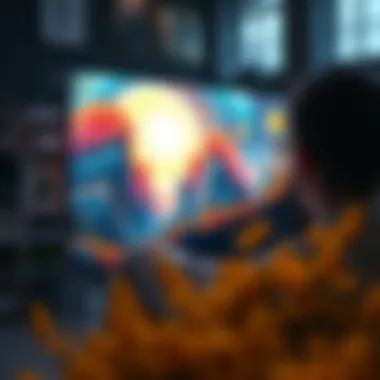
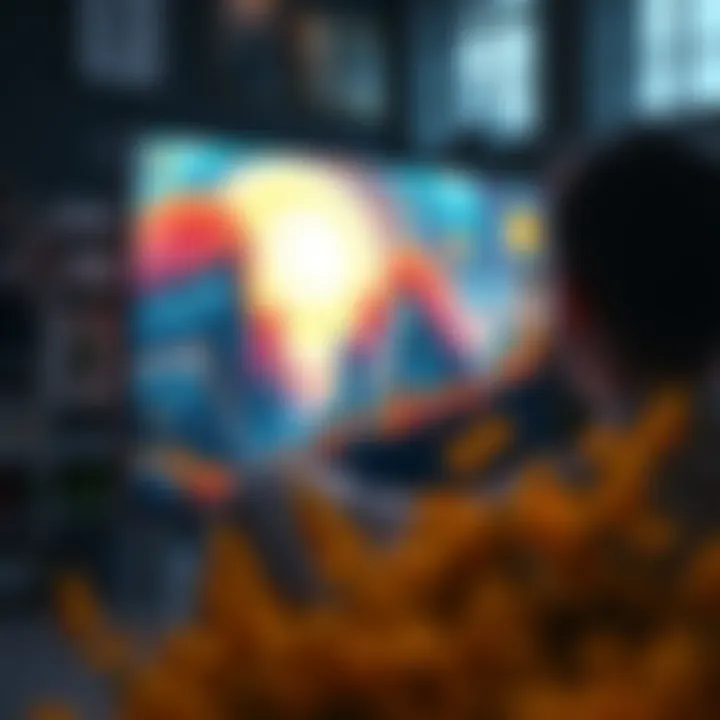
Intro
The digital sphere is buzzing with talks about NFT art. As more artists, collectors, and even casual observers dip their toes into this ocean of non-fungible tokens, understanding how to display these unique assets becomes increasingly essential. It’s not just about owning art anymore; it’s about how to showcase it, interact with it, and even share it in different formats or mediums. Exploring this topic sheds light on the various platforms and technologies that enable these exhibitions, as well as the aesthetic hurdles artists face today.
NFTs challenge traditional concepts of ownership and value, notably reshaping how creators craft and present their work. Every transaction tells part of a story about creators and their audiences, and each display of NFT art contributes to an ever-evolving narrative in the digital art marketplace. In the following sections, we plunge into the nitty-gritty of these environments, discussing how the blockchain underpins the entire system of NFTs and the implications for both seasoned collectors and those just starting out in the crypto landscape.
Preface to NFT Art
In an age where digital innovation shapes our everyday lives, understanding the realm of NFT art is crucial. NFTs, or non-fungible tokens, represent a paradigm shift in how art is created, owned, and sold. This section aims to explore the foundational elements of NFT art, unveiling its significance not just as a trend, but as a lasting evolution in the art world.
NFT art transcends traditional methods of displaying and owning art by introducing a unique layer of digital ownership. Unlike physical art, NFTs allow artists and collectors to engage in a decentralized marketplace. This democratization opens doors for creators who might not have access to traditional gallery systems, ensuring that diverse voices can find prominence.
Additionally, the narrative of NFT art is not only tied to financial aspects; it challenges and redefines the concepts of authenticity and value in an increasingly digital society. This article will delve into how these themes unravel and interact in the unique tapestry of NFT art, providing insights that are relevant for investors, tech enthusiasts, and educators alike.
Understanding how NFTs function is paramount to recognizing their purpose in the digital sphere, making the subsequent sections vital for grasping the intricacies of this phenomenon.
Defining NFTs and Their Purpose
At the heart of NFT art lies the definition of NFTs themselves. An NFT serves as a digital certificate of ownership for a specific item or piece of content, whether it be visual art, music, or even virtual real estate. Unlike cryptocurrencies like Bitcoin or Ethereum, which are interchangeable, each NFT is unique, bearing distinct data that confirms its ownership and origin.
The primary purpose of NFTs is to establish and secure ownership of digital goods. They allow creators to prove their work's originality, enabling them to showcase and sell their art in a manner reminiscent of traditional galleries. This technological framework not only supports artists financially through sales but also allows for features such as royalties on future resales. The rise of NFTs taps into the collective desire for owning a piece of digital history and culture.
The implications of NFTs stretch beyond mere ownership; they revolutionize how we view and interact with art. Artists are empowered to create new revenue streams while collectors can engage in an evolving landscape full of possibilities.
The Rise of Digital Art
The trajectory of digital art has witnessed a remarkable shift, particularly as advancements in technology have paved the way for unprecedented forms of expression. Artists are no longer confined to canvas and paint; they now utilize software, animations, and interactive media to manifest their creative visions. The internet serves as both a canvas and a marketplace, further enhancing the reach of digital artists.
In recent years, platforms dedicated to exhibiting and selling digital art, including NFTs, have surged in popularity. Traditional art institutions have begun recognizing the legitimacy of digital work, leading to collaborations and exhibitions that validate this medium. Artists like Beeple have made headlines, selling digital pieces for millions, which underscores the merging of digital creativity with serious investment potential.
Additionally, the global pandemic catalyzed a surge in online engagement, prompting both artists and buyers to explore virtual spaces for connection. As a result, digital art has not only proliferated but also occupied a significant place in contemporary culture, challenging pre-existing notions of art and its distribution.
In summary, the rise of digital art reflects both a shift in artistic expression and an evolving market ripe for exploration in future sections of this article. It is a testament to how technology reshapes creativity and commerce on a global scale.
The Concept of Ownership in the Digital Space
Ownership has fundamentally changed with the advent of digital technologies, particularly with the rise of Non-Fungible Tokens (NFTs). Understanding ownership in this context is critical, as it may redefine how we view and value creations in a world transitioning rapidly to digital environments. This section explores what ownership really means in the digital age, examining its implications for artists and collectors.
Traditional vs. Digital Ownership
In the physical world, ownership is often clear-cut. When you buy a painting, you possess a unique item that can be touched and displayed. However, in the digital realm, defining ownership is a tad more murky. Traditional ownership is straightforward; you have the asset and can do with it as you please. But with digital assets, one can merely replicate artworks infinitely without diminishing their original value. If someone copied a high-res image of the Mona Lisa, you wouldn't lose your ownership, but rather that copy would be just that—a duplicate without value.
Digital ownership, especially when it comes to NFTs, blurs these boundaries. Purchasing an NFT means you own a digital token that provides you a claim to a unique piece of art, music, or any form of digital content. This doesn’t mean you own the copyright or can control what others do with it; instead, you possess a verifiable, distinct representation of that digital asset on a blockchain. It’s like having a signed print of a famous painting—it’s special, but the original hangs in a gallery.
"Digital ownership is less about having a thing and more about holding a claim to value in the digital economy."
This new form of ownership brings both potential and pitfalls. It’s essential to grasp that just because you own an NFT, it doesn’t equate to full control. This distinction is vital for both artists and collectors.
Authenticity and Provenance
One of the critical issues surrounding digital art and NFTs is authenticity. In a space where reproduction is as easy as clicking a button, how do you verify what is genuine? Here lies the brilliance of blockchain technology. Each NFT contains metadata that includes information about its origin and history, effectively serving as a digital certificate. This brings a level of transparency and trust that traditional art markets struggle to achieve.
Provenance in the digital art scene allows artists to establish their credentials and maintain a record of the transaction history of their works. Through this system, collectors can verify the originality and previous owners of a piece, thereby supporting its value in the market. The ability to trace back the lineage of an NFT is akin to the art world’s version of a family tree—it reveals the status and importance of an artwork across time.
Yet, this authenticity doesn’t come without challenges. As NFTs proliferate, the risk of counterfeit digital creations increases. Buyers must be wary and do due diligence, ensuring they are acquiring legitimate assets.
Through recognizing authenticity and provenance, both artists and collectors can navigate the complexities of digital ownership effectively. This framework not only legitimizes ownership but also enhances the overall perception of value within this burgeoning art ecosystem.


Platforms for NFT Art Display
Navigating the realm of NFT art is akin to walking through a vast bazaar filled with enticing stalls and unique creations. The platforms that host this artwork are the very foundation of the NFT ecosystem. They are not just marketplaces; they are the venues that give digital art its voice and visibility. Understanding these platforms is essential for artists and collectors alike, as they shape the experience of buying, selling, and showcasing NFT art.
These platforms cultivate communities and drive transactions, serving as pivotal actors in this evolving narrative of digital ownership. Each marketplace comes with its own set of features, transaction fees, and audience, making it vital to choose wisely. In the end, the choices made on these platforms can impact an artist’s reach and a collector's portfolio signigicantly.
Popular NFT Marketplaces
Popular NFT marketplaces such as OpenSea, Rarible, and Foundation have paved the way for NFT art to flourish. Each of these platforms carves out its own niche while sharing common threads that ideally suit diverse needs.
- OpenSea: Known as one of the largest NFT marketplaces, it boasts an extensive range of digital items, from artwork to virtual real estate. OpenSea makes it easy for creators to mint their work and connect with potential buyers. Artists can leverage the platform's vast audience to showcase their talent.
- Rarible: This platform emphasizes community governance, allowing users to vote on features through its RARI token. Rarible is particularly appealing for artists looking for a more decentralized experience. Their approach to rewarding users with incentives aligns with the ethos of NFT ownership.
- Foundation: A curated marketplace that focuses on high-quality digital art. It invites artists to submit work, which is reviewed by others in the community. This selectivity ensures that buyers receive some of the best offerings in the NFT space.
Some other notable platforms include SuperRare, KnownOrigin, and Zora. Each of these provides unique offerings, from traditional art forms to experimental digital creations. Exploring these avenues can help collectors find the gems that suit their tastes and aspirations.
Emerging Platforms and Innovations
New players are continuously emerging in the NFT landscape, driven by the demand for innovation. Platforms like Mintable and Nifty Gateway exemplify the shift towards accessibility and ease of use.
- Mintable: Gaining traction for its user-friendly approach, Mintable allows anyone to create and sell NFTs without the need for extensive technical knowledge. It offers featured collections, making it easier for collectors to discover new talents and unique pieces.
- Nifty Gateway: Known for its focus on exclusive drops, often involving renowned artists, Nifty Gateway creates a sense of urgency and excitement around NFT releases. Their practice of allowing credit card payments broadens the audience, making it less intimidating for new collectors.
In addition to these platforms, innovations such as fractional ownership are beginning to take hold. This groundbreaking concept enables investors to own a percentage of high-value NFTs, making it possible for a broader crowd to engage with expensive artworks.
Moreover, advancements in augmented reality (AR) and virtual reality (VR) are likely to redefine how NFT art is displayed and experienced. Imagine walking through a virtual gallery, observing art pieces whose details come alive with AR technology. This not only enhances the viewing experience but also enriches the potential for art to interact with its audience.
The shift towards inclusivity and interactive experiences will define the next chapter of NFT art display, drawing in more enthusiasts and investors and transforming how art is appreciated and collected.
As new platforms continue to pop up, they bring along the promise of creativity and a fresh wave of opportunities for artists and collectors alike. Keeping an eye on these developments is crucial for anyone serious about engaging with the NFT landscape.
Aesthetic Considerations of NFT Art Display
The concept of aesthetics in NFT art display transcends mere visual appeal, reaching into the realms of experience and engagement. This segment is crucial as it shapes how audiences interact with digital artworks. How an artwork is presented has a profound impact on its reception; after all, the first impression often dictates the level of interest and emotional connection an audience may cultivate towards a piece.
Visual Presentation in Digital Galleries
Visual presentation within digital galleries is not just about what looks good; it encapsulates the very essence of how art is perceived in the NFT world. Every gallery platform—from established players like OpenSea to newer entrants—offers unique functionalities that affect how artworks are showcased. Consider color schemes, lighting effects, and layout designs. These elements can either enhance or detract from the pieces.
- Color Psychology: Colors play an emotive role in visual presentation. For example, warm hues might evoke feelings of excitement or passion, while cool tones often instill calmness. In NFT galleries, colors can set the backdrop for the art, influencing viewer mood and interpretation.
- Contextual Framing: Just as traditional galleries use wall spacing and frames to guide viewers, digital platforms also require thoughtful arrangement. Whether an artwork is placed centrally or off to the side can shift focus and engagement.
- Resolution and Quality: With NFTs, the resolution of a digital piece can drastically alter the viewer's experience. High-resolution displays ensure that intricate details can be appreciated, thus enhancing overall aesthetic appeal.
Moreover, continuous improvements in virtual reality and augmented reality technologies promise a closer connection between the viewer and the artwork. Imagine walking through a digital gallery as if it were a physical space, experiencing art in ways previously thought impossible.
"The way an artwork is showcased can alter its perceived value, transforming a digital image into a narrative that resonates more deeply with its audience."
Interactivity and User Experience
Interactivity in NFT art display considerably enriches user experience. Engagement goes beyond passive observation; it invites viewers to immerse themselves in the artwork’s narrative. Key elements contributing to interactivity include:
- User Feedback Mechanisms: From simple likes to complex community ratings, allowing users to share their opinions creates a participatory culture. This feedback loop can stimulate demand and hence affect the art's market value.
- Dynamic Elements: Incorporating video elements or animations can breathe life into static images. For instance, a painting might morph between different states based on user interaction, offering a layered experience that traditional art cannot replicate.
- Social Integration: Enabling easy sharing on social platforms can extend the reach of NFT artworks, connecting artists with a broader audience. Active discussions in forums or platforms like Reddit allow art enthusiasts to explore and dissect the aesthetics of various pieces.
- Gamification: Engaging visitors through quests or challenges related to a piece can transform passive viewing into an active pursuit, enhancing retention and emotional investment. This parallels elements familiar to gamers but seamlessly incorporates them into the art world.
In summary, the aesthetic considerations of NFT art display are pivotal. From visual presentation to interactive elements, they serve as keystones on which the artistic community can innovate and elevate the experience surrounding digital art creation and consumption. The conversation is just starting, and as technology evolves, so too will the ways in which we appreciate and interact with art.
Challenges Faced by NFT Artists
As creators navigate the new landscape offered by NFTs, it's vital to examine the tripwires and hurdles they encounter. The idea of digital art being profitable, authentic, and collectible has changed the game, yet it comes with a set of complications worthy of discussion. From dealing with oversaturated markets to the murky waters of legalities and ethics, NFT artists often find themselves juggling multiple challenges that can impact their artistry and economic viability.
Understanding these challenges is essential here because they not only influence the artist's journey but can also shape the future of the NFT art ecosystem. In the current environment, addressing these issues is imperative for artists hoping to carve out a niche in the growing world of digital collectibles.
Market Saturation and Competition
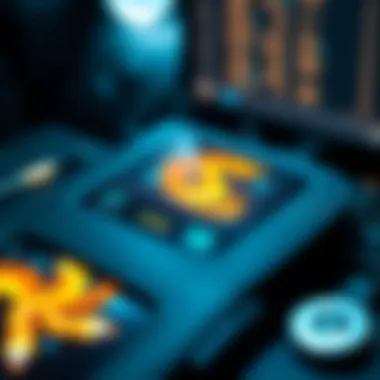
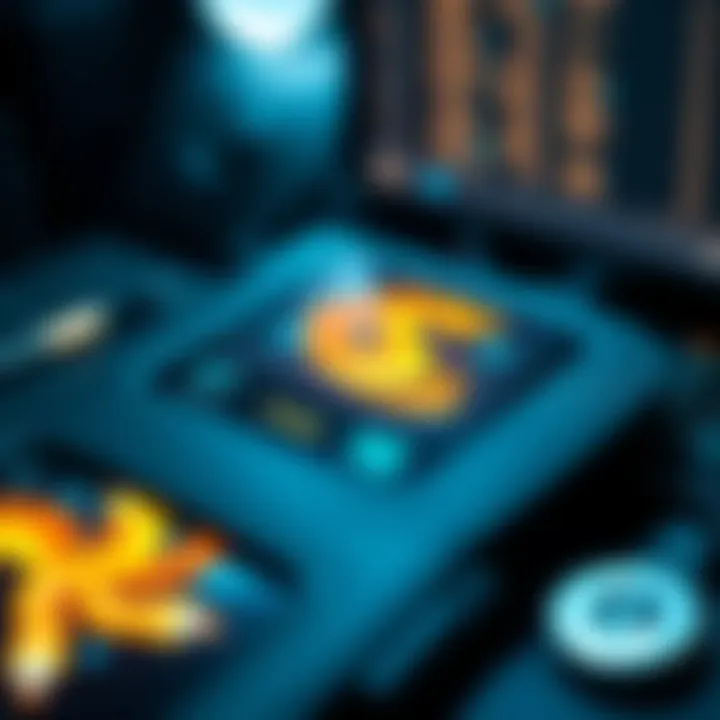
In the digital art world, the adage "too many cooks spoil the broth" rings especially true. With an explosion of NFT art platforms and artists entering the fray, market saturation has become a pressing concern. It’s like throwing a pebble into an ocean and expecting to make a big splash. The influx of creations can drown out unique voices, making it tough for individual artists to stand out.
Collectively, this saturation has birthed fierce competition. Artists who once held a distinct position now find themselves competing against countless others, each vying for attention and sales. The problem is not just the sheer number of artworks; it also includes varying quality, concept, and presentation.
To navigate this competitive landscape, many artists are turning to branding strategies that echo the principles of traditional art markets. For example:
- Strong Personal Branding: Building a recognizable persona can help establish authority and connectivity with potential buyers.
- Curation of Work: Instead of flooding the market with every piece created, focusing on a cohesive collection or thematic body of work can enhance visibility and perceived value.
- Engagement with Fans: Actively participating in communities and social media helps create loyalty and interest around an artist’s work.
These approaches may not guarantee success, but they provide a framework within which artists can thrive, even when facing a crowded marketplace.
Legal and Ethical Implications
Digital art, paired with blockchain technology, introduces a myriad of legal and ethical questions that artists must grapple with. These issues are not hurdles to be overlooked; they are complex dilemmas that can significantly affect an artist's reputation and financial standing.
Consider the issue of copyright ownership in the NFT realm. While artists typically own their creations, the underlying data and technological frameworks can complicate matters. If an artist creates an NFT out of an existing artwork or a derivative piece without permission, they can easily find themselves embroiled in legal battles that could tarnish their standing.
Moreover, ethical concerns surrounding NFTs are surfacing as discussions about environmental impacts of blockchain technology gain traction. Critics argue that minting NFTs consumes excessive energy, leading to a significant carbon footprint, and that the art communities should address these concerns to maintain integrity.
"The future of art rests not just on creativity but also on the ethics of its creation and dissemination in the digital realm."
Artists must tread carefully to navigate these waters. Ensuring proper copyright practices, exploring eco-friendly blockchain alternatives, and actively engaging in discussions about the responsibilities of creators can help artists uphold their values in the rapidly changing landscape of NFT art.
The Role of Cryptocurrency in NFT Ecosystem
The connection between cryptocurrency and NFTs is akin to the connection between oil and the automotive industry. In this digital age, cryptocurrencies act as the lifeblood of NFT ecosystems, empowering transactions and enabling artists and collectors to interact seamlessly. This section will dissect the intricate tapestry of cryptocurrency's role, focusing on key elements like payment mechanisms, token standards, and the broader implications for the art community.
Payment Mechanisms for NFTs
When it comes to acquiring NFTs, the payment methods utilized are as diverse as the art forms themselves. Most transactions hinge on cryptocurrencies such as Ethereum, Bitcoin, and sometimes even more niche coins. Each digital currency serves as a medium of exchange, enabling the purchase and sale of NFTs without the need for traditional banking channels.
One of the core advantages of using cryptocurrency for these transactions is decentralization, which brings an added layer of security and privacy for both artists and buyers. Here are a few notable points:
- Speed of Transactions: Unlike traditional payment methods that can take days to process, cryptocurrency transactions occur almost instantaneously. This immediacy enhances the buying experience, making it smoother for art collectors.
- Global Accessibility: Cryptocurrencies democratize access to the art world. Artists from remote areas can sell their work to a global audience, transcending geographical limitations.
- Lower Transaction Fees: Though there are fees associated with blockchain transactions, they often pale in comparison to the commissions charged by galleries and auction houses.
However, it’s important to note that while cryptocurrencies enable quick transactions, they are also subject to price volatility. The value of these coins can fluctuate wildly; an NFT purchased today could be worth significantly more or less just a week later.
"The bridge between traditional art and modern digital formats is powered not just by creativity, but by the cryptocurrencies that facilitate these transactions."
Token Standards in NFT Creation
Moving deeper into the mechanics of NFTs, token standards dictate how these digital assets are created, bought, and sold. The most prevalent standard in the NFT space is the ERC-721 token standard on the Ethereum blockchain. This protocol uniquely identifies each token, making sure each digital artwork is distinct and traceable.
There are other standards worth mentioning, like ERC-1155, which allows for more efficient transactions by enabling multiple token types under a single contract. This provides a layered approach to NFT transactions, allowing creativity to flourish without the constraints of traditional frameworks.
Understanding these standards is crucial for anyone looking to create or invest in NFTs. Here’s what they entail:
- Uniqueness: Each NFT created under these standards is tied to a specific piece of art, providing a unique identification code that ensures no two NFTs are the same.
- Interoperability: These standards allow NFTs to be traded across various platforms and marketplaces, creating a more fluid market for artists and collectors alike.
- Smart Contracts: On platforms like Ethereum, smart contracts govern the terms of each NFT sale. This ensures buyers and sellers enter agreements with built-in protections against fraud.
These token standards encapsulate the essence of what NFTs represent: a novel way to own and transact art in the digital ether, framing a future where creativity and technology collide in groundbreaking ways.
Cultural Impact of NFT Art
The emergence of NFT art has created a seismic shift in the cultural landscape of the art world. It has opened new doors for artists, redefining their creative boundaries and offering platforms where their work can gain global recognition. The cultural implications extend beyond the artists themselves, resonating with collectors, investors, and connoisseurs. This transformative medium challenges traditional notions of art ownership, value, and investment, making it essential to explore its cultural impact thoroughly.
Shifting Perceptions of Value in Art
At the heart of this discussion lies the evolving perception of value in art. Traditionally, the art world operated on a subjective understanding of worth, often dictated by established critics and auction houses. However, NFTs have turned this model on its head. A digital artwork can sell for millions, driven not only by its aesthetic appeal but also its rarity and the tech behind it.
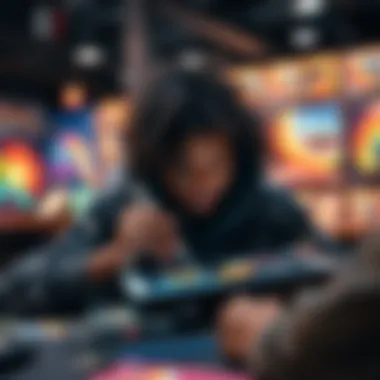
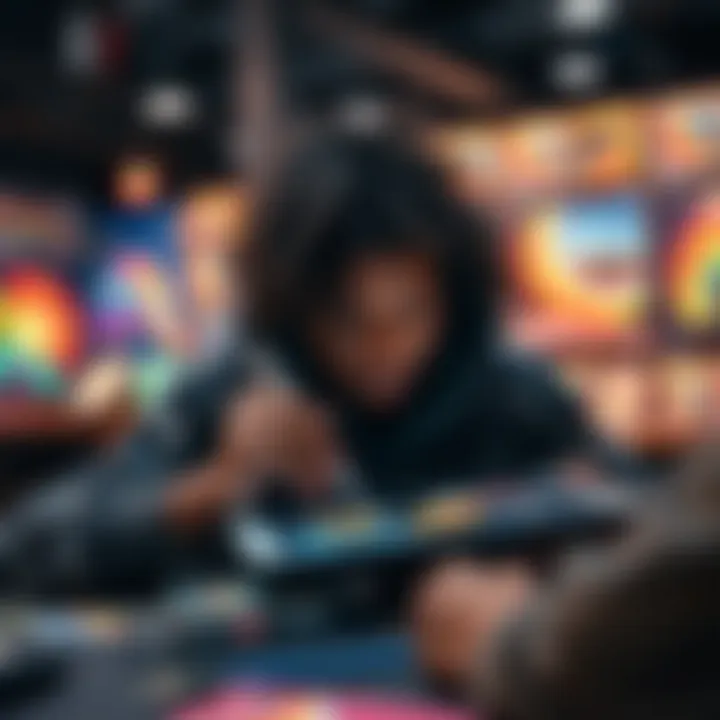
- Unlike physical art, NFTs can be verified through blockchain technology, creating a sense of authenticity and provenance unlike anything seen before.
- This shift has attracted not just art enthusiasts but also a wave of investors, leading to a rise in speculation surrounding digital art assets.
- A prime example includes the digital artist Beeple, whose piece "Everydays: The First 5000 Days" fetched a staggering $69 million at Christie’s, reshaping the public's understanding of what art can be worth.
The idea that a pixelated image might be deemed as valuable as a physical hand-painted canvas seems perplexing if we look through an old-school lens. But it’s this very unrest that nudges society to re-evaluate the essence of creativity and its worth.
NFTs and Their Role in Art Collecting
NFTs are not just a passing phase; they represent a radical rethinking of what collecting art means. The traditional art market is often exclusive, requiring deep pockets to gain access to renowned pieces. Conversely, NFTs democratize collecting, opening vast possibilities for anyone with an internet connection and a wallet.
- Collectors today can purchase works directly from artists or participate in auctions without the need for a brick-and-mortar gallery.
- The ability to buy, sell, and trade NFTs on various decentralized platforms means that collectors can engage with art on their own terms, from their homes—no more rubbing elbows at fancy benefits.
- Digital ownership is particularly appealing to younger generations who are more inclined to spend time in virtual spaces.
By embracing NFTs, artists connect with collectors in unprecedented ways. They can not only showcase their work but also explore community interactions through ownership rights, royalties, and collaborations.
"The medium is the message," as Marshall McLuhan suggested. In the case of NFTs, the medium is redefining how art moves, how it is consumed, and ultimately, how it holds value in the modern age.
In closing, the cultural impact of NFT art is monumental, setting off a chain reaction that challenges deeply rooted art norms. As technology advances and acceptance grows, the implications of these changes will continue to unfold, shaping the future of creative expression and ownership in a digital world.
The Future of NFT Art Display
The future of NFT art display holds significant importance for investors, tech enthusiasts, and educators alike. As the digital landscape continues to evolve, the impact of NFTs on the art world is profound and far-reaching. This section explores several crucial elements that shed light on the future experiences of artists, collectors, and platforms alike.
Technological Advancements on the Horizon
As we look ahead, technological advancements are set to redefine how NFT art is created, displayed, and interacted with. The integration of augmented reality (AR) and virtual reality (VR) is particularly notable. Artists may soon present their works in immersive environments, where viewers can explore the pieces more intimately.
Imagine walking through a digital gallery where you can interact with art pieces in real-time. 3D displays may allow collectors to experience the artwork from multiple angles or within various contexts. Moreover, improvements in blockchain technology can offer faster transactions and lower fees, making it easier for creators to share their work and receive compensation without the usual pitfalls.
Increased accessibility to high-speed internet, along with advancements in mobile technology, could further widen the audience for NFT art displays. This shift might lead to broader democratization of the art market, allowing not just the affluent but everyday enthusiasts to engage with high-quality digital artwork.
"The merging of art and technology is creating a new frontier where possibilities are endless."
Evolving Market Dynamics
Market dynamics surrounding NFT art are also poised for significant transformation. The influx of new buyers and the diversification of investment strategies is re-shaping who collects art and why. Factors like fractional ownership could empower art enthusiasts to invest in high-value pieces at a fraction of the cost. This could lead to a new wave of collectors who participate in art investment without having to purchase an entire work outright.
The secondary market for NFTs is likely to grow, allowing original collectors to sell pieces again, sometimes at enhanced value. This can provide artists a chance to benefit from their works even after initial sales, as rooms for resale would help preserve their value.
In addition to financial incentives, understanding the cultural impact will be essential. NFTs have the potential to transcend borders, enabling global art exchanges. As collectors from different backgrounds and cultures interact, new artistic narratives could emerge, representing a blend of diverse influences.
The ability of NFT displays to foster community engagement around art will continue to thrive, leading to discussions that encapsulate artistic values and stories. Artists and collectors collaborating on various platforms might result in innovative works that appeal to a broader audience.
Resources:
Culmination
In exploring the intricacies of NFT art display, it becomes clear that the significance of this emerging realm extends far beyond mere aesthetics. The growing intersection of technology and creativity reshapes how we perceive art, ownership, and their corresponding values. With this article, we highlighted critical aspects pertinent to the current landscape of digital art, stressing why understanding NFT art display is essential for investors, tech enthusiasts, and educators alike.
Summarizing Key Insights
From the earlier sections, a number of key insights emerge:
- Digital Ownership Redefined: Traditional views of ownership are being challenged by blockchain technology, enabling artists and collectors to enjoy more transparent, secure transactions.
- Unique Challenges: Artists now navigate potential market saturation while grappling with legalities surrounding copyright and provenance.
- Innovative Platforms: A plethora of platforms exist for displaying NFT art, ranging from established market spaces to avant-garde venues that emphasize user experience.
- Cultural Shifts: As perceptions of art value evolve, NFTs position themselves as collectible assets influencing traditional art markets.
Summarily, these insights underscore the pressing need for a deeper understanding of NFT art display, which may serve as a crucial touchpoint in the confluence of technology and social change.
Final Thoughts on NFT Art Display
As we look ahead, the future of NFT art display holds shimmering possibilities. Ongoing technological advancements suggest that experiences surrounding digital art will become increasingly immersive. With virtual and augmented reality integrations on the horizon, collectors and artists alike may find themselves cruising toward a time where experiences and interactions define value, breaking away from static forms of appreciation.
The dynamic landscape of NFTs also indicates shifting market dynamics where distinctions between average investors and seasoned collectors may blur. Individuals keen on harnessing the potential of NFT art must not only comprehend the platforms but also stay attuned to evolving trends and cultural shifts.
In grasping the nuances of NFT art display, one appreciates how this digital evolution is reshaping artistry today, forging paths for creatives while calling for innovative responses from audiences. Whether you are an investor probing the depths of digital asset allocation or an educator fostering discourse around digital art, understanding NFT art display is not just advantageous—it's essential in today’s rapidly changing art world.







